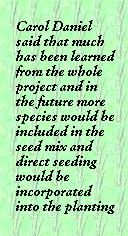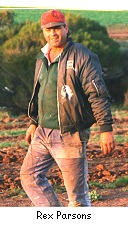
The Gairdner River is 250 kilometres in length and it travels southeast through the Shire of Jerramungup into the Gordon Inlet adjacent to Bremer Bay. It flows during winter for a few days or weeks after very heavy or prolonged rainfall. Most years the flow is very low and is negligible in dry years. There are some permanent and ephemeral river pools along its length. At present 90% of the main river channel is fenced and the rest is secured in reserves.
In 1996 the Upper Gairdner Subregional Catchment Strategy was initiated, which resulted in 484 kilometres of fencing, 379 kilometres earthworks, 300 kilograms direct seeding and 300,000 seedlings being planted. The three year project was funded by the Natural Heritage Trust (NHT) and involved 61 landowners and 110,000 hectares. Carol Daniel of the Jerramungup Landcare Centre coordinated the project.
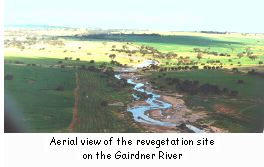 The issues being addressed by the strategy included:
The issues being addressed by the strategy included:
- rapidly rising water tables
- siltation of the Gairdner River
- salinisation of farm land
- erosion of the creek and river channels
- rapid decline of native vegetation
- eutrophication of the upper Gairdner River reaches
As part of the strategy a highly degraded site was chosen for fencing and revegetation. The site was where the Gairdner River crossed Highway 1, just east of Jerramungup. It was highly visible to the public and would therefore be useful for raising community awareness of the project and would also improve the aesthetics of the site. The valley at this point is relatively steep and incised and has a granite basement. The original vegetation would have been yate (Eucalyptus occidentalis), sheoak (Allocasuarina) and wattle (Acacia species) with an understorey of native grasses and sedges.
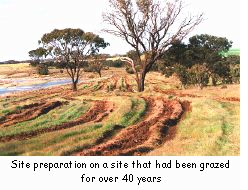 The Solution
The Solution
In July 1996 Green Scene Nursery planted 46 000 seedlings in the riparian zone on either side of the Gairdner River bridge and Green Skills applied fertiliser during August 1996. The landowner, Rex Parsons, completed 7.5 kilometres of fencing, deep ripping to a depth of 600 mm. and weed spraying prior to the planting. After deep ripping, tithing was carried out to eliminate air pockets from the soil.
Local species were selected by Nathan McQuoid (Greening Western Australia - formerly Ranger in Charge, Fitzgerald River National Park) who visited a nearby reserve at Calyerup Rocks to establish what would have been growing at the site prior to clearing. Local seed was requested, where possible, from Green Scene Nursery.
The Jerramungup School children conducted an experiment at the site that looked at the germination of stored seed using 'smoke water' technology. They built a machine that produced smoked water and applied the water to the ground where there had been over 30 years of grazing. Nothing grew on any of the trial plots. An arboretum was established as part of the project and 20 species were planted close to the road.
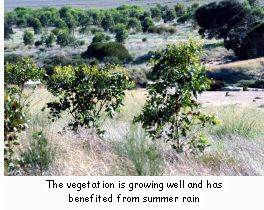 The Outcomes and Observations
The Outcomes and Observations
The vegetation is growing well and has benefited from summer rain. Carol Daniel said that much has been learned from the whole project and in the future more species would be included in the seed mix and direct seeding would be incorporated into the planting. She believes that the project has been a catalyst for landowners to continue their own revegetation and Rex Parsons has planted a further 10,000 seedlings each year on his property since the start of the project.
Gairdner River Catchment Statistics
| Catchment area: | 110 000 hectares | |
| Type of stream: | Ephemeral river | |
| Average rainfall: | 375 mm./year | |
| Water quality: | Saline | |
| Catchment disturbances: | Stock grazing, cropping |

